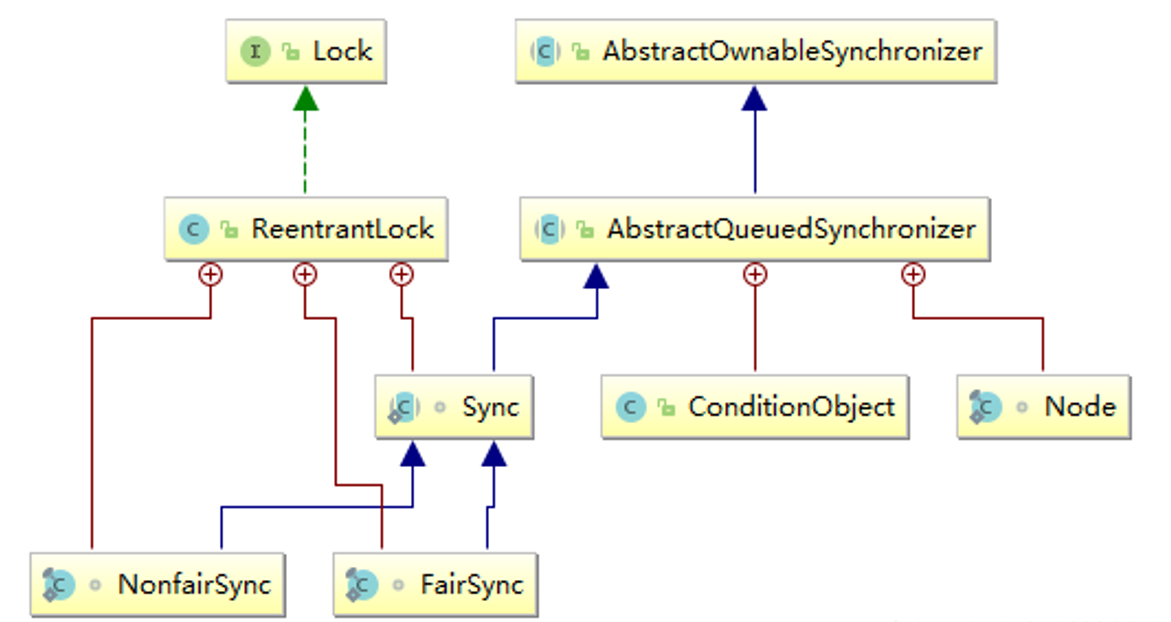本篇博客中的大部分内容并非原创,仅做整理作为学习资料使用
参考:https://www.cnblogs.com/tong-yuan/p/ReentrantLock.html
简介 ReentrantLock 是 AQS 独占模式的典型示例,接下来我们分析 ReentrantLock 是如何实现的。
根据类图,我们可以发现,ReentrantLock实现了Lock接口,Lock接口里面定义了java中锁应该实现的几个方法:
1 2 3 4 5 6 7 8 9 10 11 12 void lock () ;void lockInterruptibly () throws InterruptedException;boolean tryLock () ;boolean tryLock (long time, TimeUnit unit) throws InterruptedException;void unlock () ;Condition newCondition () ;
Lock接口中主要定义了 获取锁、尝试获取锁、释放锁、条件锁等几个方法。
源码分析 主要内部类 ReentrantLock中主要定义了三个内部类:Sync、NonfairSync、FairSync。
1 2 3 abstract static class Sync extends AbstractQueuedSynchronizer {}static final class FairSync extends Sync {}static final class NonfairSync extends Sync
(1)抽象类Sync实现了AQS的部分方法;
(2)NonfairSync实现了Sync,主要用于非公平锁的获取;
(3)FairSync实现了Sync,主要用于公平锁的获取。
主要属性 1 private final Sync sync;
主要属性就一个sync,它在构造方法中初始化,决定使用公平锁还是非公平锁的方式获取锁。
主要构造方法 1 2 3 4 5 6 7 8 public ReentrantLock () { sync = new NonfairSync (); } public ReentrantLock (boolean fair) { sync = fair ? new FairSync () : new NonfairSync (); }
(1)默认构造方法使用的是非公平锁;
(2)第二个构造方法可以自己决定使用公平锁还是非公平锁;
上面我们分析了ReentrantLock的主要结构,下面我们跟着几个主要方法来看源码。
lock()方法 公平锁 这里我们假设ReentrantLock的实例是通过以下方式获得的:
1 ReentrantLock reentrantLock = new ReentrantLock (true );
下面的是加锁的主要逻辑:
1 2 3 4 5 6 7 8 9 10 11 12 13 14 15 16 17 18 19 20 21 22 23 24 25 26 27 28 29 30 31 32 33 34 35 36 37 38 39 40 41 42 43 44 45 46 47 48 49 50 51 52 53 54 55 56 57 58 59 60 61 62 63 64 65 66 67 68 69 70 71 72 73 74 75 76 77 78 79 80 81 82 83 84 85 86 87 88 89 90 91 92 93 94 95 96 97 98 99 100 101 102 103 104 105 106 107 108 109 110 111 112 113 114 115 116 117 118 119 120 121 122 123 124 125 126 127 128 129 130 131 132 133 134 135 136 137 138 139 140 141 142 143 144 145 146 147 148 149 150 151 152 153 154 155 156 157 158 159 160 161 162 163 164 165 166 167 168 169 170 171 172 173 174 175 176 177 178 179 180 181 182 183 184 185 186 187 188 189 public void lock () { sync.lock(); } final void lock () { acquire(1 ); } public final void acquire (int arg) { if (!tryAcquire(arg) && acquireQueued(addWaiter(Node.EXCLUSIVE), arg)) selfInterrupt(); } protected final boolean tryAcquire (int acquires) { final Thread current = Thread.currentThread(); int c = getState(); if (c == 0 ) { if (!hasQueuedPredecessors() && compareAndSetState(0 , acquires)) { setExclusiveOwnerThread(current); return true ; } } else if (current == getExclusiveOwnerThread()) { int nextc = c + acquires; if (nextc < 0 ) throw new Error ("Maximum lock count exceeded" ); setState(nextc); return true ; } return false ; } private Node addWaiter (Node mode) { Node node = new Node (Thread.currentThread(), mode); Node pred = tail; if (pred != null ) { node.prev = pred; if (compareAndSetTail(pred, node)) { pred.next = node; return node; } } enq(node); return node; } private Node enq (final Node node) { for (;;) { Node t = tail; if (t == null ) { if (compareAndSetHead(new Node ())) tail = head; } else { node.prev = t; if (compareAndSetTail(t, node)) { t.next = node; return t; } } } } final boolean acquireQueued (final Node node, int arg) { boolean failed = true ; try { boolean interrupted = false ; for (;;) { final Node p = node.predecessor(); if (p == head && tryAcquire(arg)) { setHead(node); p.next = null ; failed = false ; return interrupted; } if (shouldParkAfterFailedAcquire(p, node) && parkAndCheckInterrupt()) interrupted = true ; } } finally { if (failed) cancelAcquire(node); } } private static boolean shouldParkAfterFailedAcquire (Node pred, Node node) { int ws = pred.waitStatus; if (ws == Node.SIGNAL) return true ; if (ws > 0 ) { do { node.prev = pred = pred.prev; } while (pred.waitStatus > 0 ); pred.next = node; } else { compareAndSetWaitStatus(pred, ws, Node.SIGNAL); } return false ; } private final boolean parkAndCheckInterrupt () { LockSupport.park(this ); return Thread.interrupted(); }
下面我们看一下主要方法的调用关系:
1 2 3 4 5 6 7 8 9 ReentrantLock#lock() ->ReentrantLock.FairSync#lock() ->AbstractQueuedSynchronizer#acquire() ->ReentrantLock.FairSync#tryAcquire() ->AbstractQueuedSynchronizer#addWaiter() ->AbstractQueuedSynchronizer#enq() ->AbstractQueuedSynchronizer#acquireQueued() ->AbstractQueuedSynchronizer#shouldParkAfterFailedAcquire() ->AbstractQueuedSynchronizer#parkAndCheckInterrupt()
获取锁的主要过程大致如下:
(1)尝试获取锁,如果获取到了就直接返回了;
(2)尝试获取锁失败,再调用addWaiter()构建新节点并把新节点入队;
(3)然后调用acquireQueued()再次尝试获取锁,如果成功了,直接返回;
(4)如果再次失败,再调用shouldParkAfterFailedAcquire()将节点的等待状态置为等待唤醒(SIGNAL);
(5)调用parkAndCheckInterrupt()阻塞当前线程;
(6)如果被唤醒了,会继续在acquireQueued()的for()循环再次尝试获取锁,如果成功了就返回;
(7)如果不成功,再次阻塞,重复(3)(4)(5)直到成功获取到锁。
以上就是整个公平锁获取锁的过程,下面我们看看非公平锁是怎么获取锁的。
非公平锁 1 2 3 4 5 6 7 8 9 10 11 12 13 14 15 16 17 18 19 20 21 22 23 24 25 26 27 28 29 30 31 32 33 34 35 36 37 38 39 40 41 42 43 44 45 46 public void lock () { sync.lock(); } final void lock () { if (compareAndSetState(0 , 1 )) setExclusiveOwnerThread(Thread.currentThread()); else acquire(1 ); } public final void acquire (int arg) { if (!tryAcquire(arg) && acquireQueued(addWaiter(Node.EXCLUSIVE), arg)) selfInterrupt(); } protected final boolean tryAcquire (int acquires) { return nonfairTryAcquire(acquires); } final boolean nonfairTryAcquire (int acquires) { final Thread current = Thread.currentThread(); int c = getState(); if (c == 0 ) { if (compareAndSetState(0 , acquires)) { setExclusiveOwnerThread(current); return true ; } } else if (current == getExclusiveOwnerThread()) { int nextc = c + acquires; if (nextc < 0 ) throw new Error ("Maximum lock count exceeded" ); setState(nextc); return true ; } return false ; }
相对于公平锁,非公平锁加锁的过程主要有两点不同:
(1)一开始就尝试CAS更新状态变量state的值,如果成功了就获取到锁了;
(2)在tryAcquire()的时候没有检查是否前面有排队的线程,直接上去获取锁才不管别人有没有排队呢;
总的来说,相对于公平锁,非公平锁在一开始就多了两次直接尝试获取锁的过程。
lockInterruptibly()方法 支持线程中断,它与lock()方法的主要区别在于lockInterruptibly()获取锁的时候如果线程中断了,会抛出一个异常,而lock()不会管线程是否中断都会一直尝试获取锁,获取锁之后把自己标记为已中断,继续执行自己的逻辑,后面也会正常释放锁。
题外话:
线程中断,只是在线程上打一个中断标志,并不会对运行中的线程有什么影响,具体需要根据这个中断标志干些什么,用户自己去决定。
比如,如果用户在调用lock()获取锁后,发现线程中断了,就直接返回了,而导致没有释放锁,这也是允许的,但是会导致这个锁一直得不到释放,就出现了死锁。
1 2 3 4 5 6 7 lock.lock(); if (Thread.currentThread().interrupted()) { return ; } lock.unlock();
当然,这里只是举个例子,实际使用肯定是要把lock.lock()后面的代码都放在try…finally…里面的以保证锁始终会释放,这里主要是为了说明线程中断只是一个标志,至于要做什么完全由用户自己决定。
tryLock()方法 尝试获取一次锁,成功了就返回true,没成功就返回false,不会继续尝试。
1 2 3 4 5 6 7 8 9 10 11 12 13 14 15 16 17 18 19 20 21 22 23 24 public boolean tryLock () { return sync.nonfairTryAcquire(1 ); } final boolean nonfairTryAcquire (int acquires) { final Thread current = Thread.currentThread(); int c = getState(); if (c == 0 ) { if (compareAndSetState(0 , acquires)) { setExclusiveOwnerThread(current); return true ; } } else if (current == getExclusiveOwnerThread()) { int nextc = c + acquires; if (nextc < 0 ) throw new Error ("Maximum lock count exceeded" ); setState(nextc); return true ; } return false ; }
tryLock()方法比较简单,直接以非公平的模式去尝试获取一次锁,获取到了或者锁本来就是当前线程占有着就返回true,否则返回false 。
tryLock(long time, TimeUnit unit)方法 尝试获取锁,并等待一段时间,如果在这段时间内都没有获取到锁,就返回false。
1 2 3 4 5 6 7 8 9 10 11 12 13 14 15 16 17 18 19 20 21 22 23 24 25 26 27 28 29 30 31 32 33 34 35 36 37 38 39 40 41 42 43 44 45 46 47 48 49 50 51 52 53 54 public boolean tryLock (long timeout, TimeUnit unit) throws InterruptedException { return sync.tryAcquireNanos(1 , unit.toNanos(timeout)); } public final boolean tryAcquireNanos (int arg, long nanosTimeout) throws InterruptedException { if (Thread.interrupted()) throw new InterruptedException (); return tryAcquire(arg) || doAcquireNanos(arg, nanosTimeout); } private boolean doAcquireNanos (int arg, long nanosTimeout) throws InterruptedException { if (nanosTimeout <= 0L ) return false ; final long deadline = System.nanoTime() + nanosTimeout; final Node node = addWaiter(Node.EXCLUSIVE); boolean failed = true ; try { for (;;) { final Node p = node.predecessor(); if (p == head && tryAcquire(arg)) { setHead(node); p.next = null ; failed = false ; return true ; } nanosTimeout = deadline - System.nanoTime(); if (nanosTimeout <= 0L ) return false ; if (shouldParkAfterFailedAcquire(p, node) && nanosTimeout > spinForTimeoutThreshold) LockSupport.parkNanos(this , nanosTimeout); if (Thread.interrupted()) throw new InterruptedException (); } } finally { if (failed) cancelAcquire(node); } }
tryLock(long time, TimeUnit unit)方法在阻塞的时候加上阻塞时间,并且会随时检查是否到期,只要到期了没获取到锁就返回false。
unlock()方法 释放锁。
1 2 3 4 5 6 7 8 9 10 11 12 13 14 15 16 17 18 19 20 21 22 23 24 25 26 27 28 29 30 31 32 33 34 35 36 37 38 39 40 41 42 43 44 45 46 47 48 49 50 51 52 53 54 55 56 57 58 59 60 public void unlock () { sync.release(1 ); } public final boolean release (int arg) { if (tryRelease(arg)) { Node h = head; if (h != null && h.waitStatus != 0 ) unparkSuccessor(h); return true ; } return false ; } protected final boolean tryRelease (int releases) { int c = getState() - releases; if (Thread.currentThread() != getExclusiveOwnerThread()) throw new IllegalMonitorStateException (); boolean free = false ; if (c == 0 ) { free = true ; setExclusiveOwnerThread(null ); } setState(c); return free; } private void unparkSuccessor (Node node) { int ws = node.waitStatus; if (ws < 0 ) compareAndSetWaitStatus(node, ws, 0 ); Node s = node.next; if (s == null || s.waitStatus > 0 ) { s = null ; for (Node t = tail; t != null && t != node; t = t.prev) if (t.waitStatus <= 0 ) s = t; } if (s != null ) LockSupport.unpark(s.thread); }
释放锁的过程大致为:
(1)将state的值减1;
(2)如果state减到了0,说明已经完全释放锁了,唤醒下一个等待着的节点;
彩蛋 为什么ReentrantLock默认采用的是非公平模式?
答:因为非公平模式效率比较高。
为什么非公平模式效率比较高?
答:因为非公平模式会在一开始就尝试两次获取锁,如果当时正好state的值为0,它就会成功获取到锁,少了排队导致的阻塞/唤醒过程,并且减少了线程频繁的切换带来的性能损耗。
非公平模式有什么弊端?
答:非公平模式有可能会导致一开始排队的线程一直获取不到锁,导致线程饿死。








